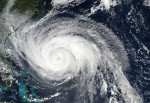
Sunday, October 1st, 2017
By Dr. Ahmed Abukhater As Hurricane Harvey made landfall on the Texas Gulf Coast on Aug. 25, 2017, with winds topping 130 miles per hour, the situation signaled a disaster on the horizon. The winds and heavy rains caused significant flooding, toppled branches and power lines, and lead to massive blackouts across the region. With

Tuesday, March 17th, 2015
One of the hottest topics recently in the world of IT, and in business in general, is just how the massive volume of available data, better known by the moniker ‘Big Data’, can be explored to optimize business results and be decisive in the creation of innovative new products and services.

Monday, November 24th, 2014
Fears are often illogical, but their promotion can convert them to legal realities. Is there reason to fear drones? Can they snoop, maim and kill? Yes, to the extent that guns, cars and planes can. However, we have learned to live with those deadly devices. Are these devices useful? Did we stop buying guns and

Tuesday, November 4th, 2014
One of the greatest challenges in location analytics is the optimization and acceleration of the relational database model. Significant numbers of local, state, and federal government users, combined with substantial commercial interests, have developed relational databases for storage and retrieval of spatial topology and geometry –points, lines, and polygons using IBM’s DB2 technology.

Tuesday, August 19th, 2014
For the past 20 years, numerous enterprising primary and secondary educators have used GIS to engage their students in real-world investigations from local to global scale. GIS in education has recently received a tremendous boost through Esri’s participation in the White House’s ConnectEd initiative. Through the initiative, designed to strengthen Science, Technology, Engineering, and Mathematics

Tuesday, July 22nd, 2014
Unmanned Aerial Vehicles (UAVs), already popular with hobbyists, are gaining the interest of map-making professionals. Perhaps you’ve played with a remotely controlled model plane or multi-rotor-copter. Within a year, Unmanned Autonomous Vehicles (also known as UAVs) – drones used by military services – will integrate into U.S. airspace for civilian, governmental, commercial, and scientific purposes.

Monday, April 21st, 2014
Since 1994, I have participated in, facilitated, and lead a variety of standards activities. I have helped develop standards in the OGC, OASIS, ISO, OMA, IETF, W3C – the list goes on. Given this commitment to the standards world, you might think that I have a strong bias toward the status-quo for standards development and

Monday, April 14th, 2014
Sensing technologies are producing unprecedented amounts of data about the environment and the digital world. The current question is: how can we gain true insight from all the available measurements? Industries are orienting development towards new systems built around higher requirements of performance and scale. Effective storage is an important precondition for big data analytics,

Tuesday, April 1st, 2014
GIS professionals familiar with the National Spatial Data Infrastructure’s seven Framework Data Layers know that these are just the beginning of a multitude of layers and themes compiled to build effective GIS databases. Many states have plans for additional statewide framework layers to supplement the Federal NSDI. California has prioritized eleven. These map-data layers are